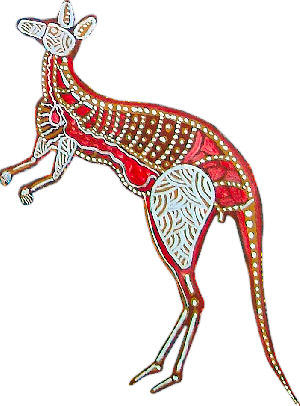Aboriginal Symbols of Fauna and Wildlife
| WARNING: Aboriginal and Torres Strait Islander people are warned that this website contain images, voices and names of people who have passed away. |
Tracks in the Sand – Indigenous Symbols, Iconography and Imagery
- Aboriginal Symbols
———————————— - Man Woman Child
- Human Activity
- Tools & Weapons
———————————— - Bush Food
- Bush Medicine
- Wildlife
- Honey ant
- Kangaroo
- Thorny Devil
- Witchetty Grub
———————————
- Landscape & Country
- Rain & Water
————————————
The aboriginal artists use more then just the dotted symbols that is associated with the aboriginal art movement. Outside of the landscape artists who themselves have developed their own style, aboriginal artists create a variety of brush strokes using a variety of painting tools that vary from wooden skewers, forks, scrunched up plastic bags, and a variety of plant parts.
Common among the many aboriginal artists is their use of indigenous symbols, iconography and imagery that form the foundation of many aboriginal artwork seen today. Some artist of course have created their own particular style, that may continue through their family line.
Imagery of animals and wildlife are often depicted as foot steps and tracks, reflecting the real life tracks that are often left in the sandy ground of animals that have passed by.

Some artists have just used the arrow, pointing the way that the animal has travelled. The arrow being part of the narrative of the dreaming story.
Other artists depict the environment of the creature, such as the example of the frogs (represented by the brown circular shapes) burrowed in the ground around the waterholes (the blue circular shapes).
Variation on the way the animals tracks are depicted occur between different artists in their paintings; the tracks of the animal also most likely pointed in the direction that they passed by.
Dreaming stories of the emu, may extend to more then just the footstep, with some artist depicting the shape of the emu in the night sky.
Emus were considered creator spirits that flew over the land. You can see the emu in the sky when you look south to the Southern Cross. The dark patch between the stars of the head, with the neck, body and legs being formed from dust lanes stretching across the Milky Way.
Other variation on form include the kangaroo, showing their footsteps, footsteps and tail, and how they move through the landscape.
Most depiction of wildlife also provide food for Aboriginal people. Images of honey ants, witchetty grubs, kangaroos and goannas, may appear in ‘Bush Tucker’ artwork, and are not necessarily limited to those alone.
Other images that are often found in dreamtime stories or are the totem of the artist can also be depicted in a more recognisable form, sometimes as outlines of the animal, sometimes in x-ray like forms, often stylised.

